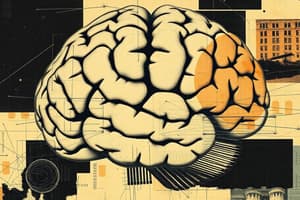Podcast
Questions and Answers
What is the primary role of glutamate in the nervous system?
What is the primary role of glutamate in the nervous system?
- Mood stabilization
- Inhibitory neurotransmission
- Pain perception
- Enhancing learning and memory (correct)
Which neurotransmitter is primarily involved in the reduction of anxiety?
Which neurotransmitter is primarily involved in the reduction of anxiety?
- Serotonin
- Norepinephrine
- GABA (correct)
- Dopamine
What do ionotropic receptors primarily influence?
What do ionotropic receptors primarily influence?
- Ion channels (correct)
- Metabolic pathways
- Gene expression
- Hormonal release
Which neurotransmitter is closely associated with feelings of pleasure and reward?
Which neurotransmitter is closely associated with feelings of pleasure and reward?
What effect does low serotonin levels have on behavior?
What effect does low serotonin levels have on behavior?
What neurotransmitter pathway is primarily involved in the regulation of mood and emotion?
What neurotransmitter pathway is primarily involved in the regulation of mood and emotion?
Which of the following neurotransmitters is primarily involved in arousal and alertness?
Which of the following neurotransmitters is primarily involved in arousal and alertness?
How do neurotransmitters terminate their action in the synaptic cleft?
How do neurotransmitters terminate their action in the synaptic cleft?
Study Notes
Types of Neurotransmitters
-
Amino Acids:
- Glutamate: Primary excitatory neurotransmitter, involved in learning and memory.
- GABA (Gamma-Aminobutyric Acid): Primary inhibitory neurotransmitter, reduces neuronal excitability.
-
Biogenic Amines:
- Dopamine: Involved in reward, motivation, and motor control.
- Norepinephrine: Associated with alertness and arousal; affects mood.
- Serotonin: Regulates mood, appetite, and sleep.
-
Peptides:
- Endorphins: Natural pain relievers; reduce stress and increase pleasure.
- Substance P: Involved in pain perception and inflammatory responses.
-
Gasotransmitters:
- Nitric Oxide: Plays a role in vasodilation and neurotransmission.
Mechanism Of Action
-
Release and Binding:
- Neurotransmitters are released from presynaptic neurons and bind to receptors on postsynaptic neurons.
-
Receptor Types:
- Ionotropic Receptors: Fast response; directly influence ion channels.
- Metabotropic Receptors: Slow response; activate second messengers and signaling pathways.
-
Reuptake and Degradation:
- Neurotransmitters are taken back into the presynaptic neuron or broken down by enzymes, terminating their action.
Role In Mood Regulation
- Dopamine: Associated with feelings of pleasure and reward; imbalances can lead to depression or mood disorders.
- Serotonin: Crucial for mood stabilization; low levels are linked to depression and anxiety.
- Norepinephrine: Influences alertness and energy; imbalances can contribute to mood disorders.
Effects On Behavior
- Motivation: Dopamine influences goal-directed behavior; deficiencies can reduce motivation.
- Anxiety and Stress: GABA reduces anxiety; imbalances can lead to increased anxiety and stress responses.
- Aggression and Impulsivity: Serotonin regulates impulse control; low levels may increase aggression and risk-taking behaviors.
Neurotransmitter Pathways
-
Mesolimbic Pathway:
- Involves dopamine; critical for reward and reinforcement.
-
Serotonergic Pathways:
- Involves serotonin; impacts mood, emotion, and cognition.
-
Noradrenergic Pathways:
- Involves norepinephrine; affects arousal, vigilance, and stress responses.
-
GABAergic Pathways:
- Involves GABA; modulates anxiety and relaxation responses.
Types of Neurotransmitters
-
Amino Acids:
- Glutamate is the main excitatory neurotransmitter, playing a key role in learning and memory processes.
- GABA (Gamma-Aminobutyric Acid) is the primary inhibitory neurotransmitter, which helps to decrease neuronal excitability.
-
Biogenic Amines:
- Dopamine contributes to sensations of reward, motivation, and motor control.
- Norepinephrine is important for maintaining alertness, arousal, and influencing mood.
- Serotonin is essential for regulating mood, appetite, and sleep patterns.
-
Peptides:
- Endorphins serve as natural pain relievers, alleviating stress and enhancing feelings of pleasure.
- Substance P is significant in the processes of pain perception and responses to inflammation.
-
Gasotransmitters:
- Nitric Oxide functions in both vasodilation and neurotransmission, influencing various physiological responses.
Mechanism Of Action
-
Release and Binding:
- Neurotransmitters are released from the presynaptic neuron and attach to receptors on the postsynaptic neuron, initiating a response.
-
Receptor Types:
- Ionotropic Receptors provide rapid responses by directly affecting ion channel activity.
- Metabotropic Receptors elicit slower responses by activating second messenger systems and altering intracellular signaling pathways.
-
Reuptake and Degradation:
- Neurotransmitters are either reabsorbed into the presynaptic neuron or enzymatically degraded, which stops their effects.
Role In Mood Regulation
-
Dopamine:
- This neurotransmitter is linked to feelings of pleasure; imbalances can lead to mood disorders like depression.
-
Serotonin:
- It is vital for mood stability, with low serotonin levels being associated with conditions like depression and anxiety.
-
Norepinephrine:
- This neurotransmitter affects energy and alertness, and its imbalance can also lead to mood-related issues.
Effects On Behavior
-
Motivation:
- Dopamine drives goal-oriented behavior; lack of dopamine can lead to reduced motivational levels.
-
Anxiety and Stress:
- GABA functions to lower anxiety; when its levels are imbalanced, individuals may experience higher anxiety and stress.
-
Aggression and Impulsivity:
- Serotonin plays a crucial role in impulse regulation; lower levels may lead to increased aggression and risky behavior.
Neurotransmitter Pathways
-
Mesolimbic Pathway:
- This pathway involves dopamine and is fundamental in reward and reinforcement mechanisms.
-
Serotonergic Pathways:
- These pathways involve serotonin and significantly influence mood, emotional responses, and cognitive functions.
-
Noradrenergic Pathways:
- Notably linked to norepinephrine, affecting levels of arousal, vigilance, and responses to stress.
-
GABAergic Pathways:
- Centered around GABA, these pathways help regulate anxiety levels and promote relaxation.
Studying That Suits You
Use AI to generate personalized quizzes and flashcards to suit your learning preferences.
Description
Explore the different types of neurotransmitters, including amino acids, biogenic amines, peptides, and gasotransmitters. This quiz will also delve into their mechanisms of action, such as release, binding, and receptor types. Test your knowledge on how these neurotransmitters influence brain function and behavior.




